Garden Designers Share Their Must-Have Plants For Winter Interest

Reviewed By PETER LICKORISH

Peter is a Horticulture Lecturer and self-employed Horticulturist, with a passion for diverse areas of the industry - from garden design to the science behind plant growth and propagation. He has completed the Royal Horticultural Society’s Master of Horticulture (MHort) Award and lectures on RHS courses at Bedford College.
Contributions From SUNIL PATEL

Sunil is the owner and curator of the garden at 13 Broom Acres, which is open to the public during the summer months under the National Garden Scheme. He has also published a book, ‘A Year In A Small Garden’, about the changes over the course of a year in his garden.

Val Bourne is a GMG award-winning gardener, lecturer and author who is known for her organic gardening style - with experience dating back over 60 years. She has an allotment and has published several books on natural gardening, including 'The Ten-Minute Gardener' and 'Colour In The Garden'.

After rising to prominence in 2005 with a presenting job on BBC Garden School, David Keegan has built a successful career in garden and landscape design. He now runs his own practice, DK Garden Design, which works on projects in the Northwest of England. He is the only person to have been awarded the Northern Design Award for Best Garden Design four times.

Ian McBain is the founder of Tythorne Garden Design, a company he started in 2004. With a strong educational background in design from the Royal College of Art, he is also actively involved in the gardening community, speaking at events and serving customers in Grantham and surrounding areas. Ian is a Registered Member of the Society of Garden Designers and an Accredited Garden Designer with the APL.
Winter can often leave your garden feeling neglected and bare, with many perennial plants entering a period of dormancy during the coldest months.
However, there are many plants that can still inject some colourful interest into your garden displays – even during these darker weeks of the year.
“Each month has its own character and set of star plants, but I love that through the depths of winter, you can smell the heady scent of winter honeysuckle, Sarcococca or Chimonanthus praecox,” shares the owner of the garden at 13 Broom Acres, Sunil Patel.
“This makes winter one of my favourite times in the gardening calendar.”
Garden Writer Val Bourne also favours the wintertime for her gardening needs:
“I actually love winter gardening, which sounds strange. I get so much done during that time of year – it is definitely my favourite season.
“When everything is stripped back to silhouettes and there are tiny flowers growing from the ground – winter is just so beautiful.”
Below, I’ve compiled a list of ten of my favourite plants for winter interest, from evergreen varieties with stunning foliage to perennials that produce flowers in a range of hues throughout the coldest of months.
1) Christmas Rose
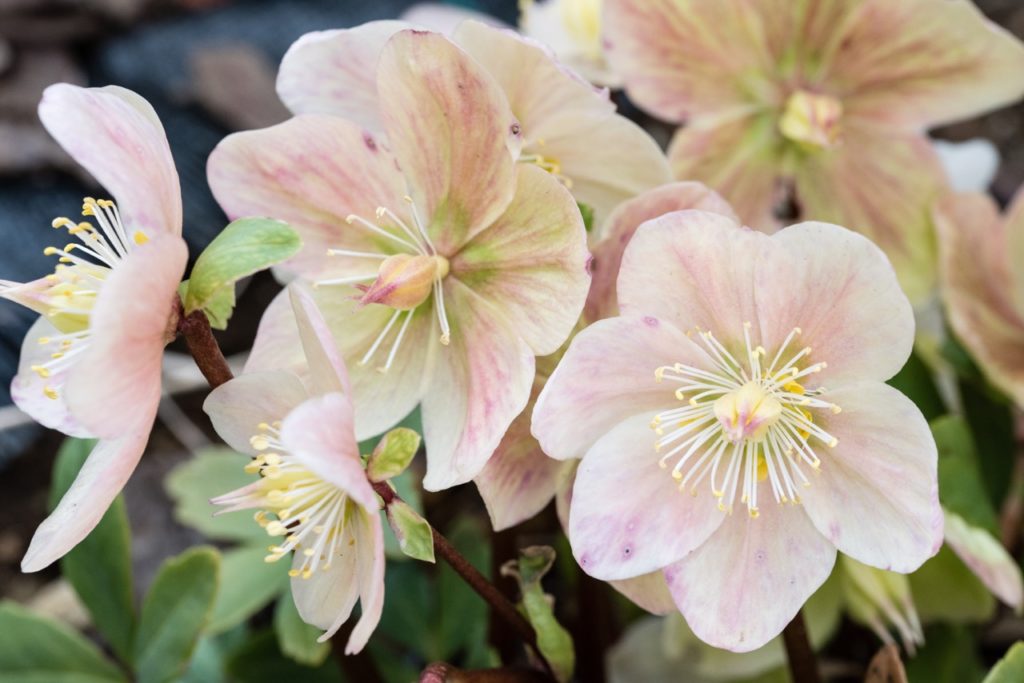
- BOTANICAL NAME: Helleborus niger
- HARDINESS RATING: H7
- PLANT TYPE: perennial
- FOLIAGE TYPE: evergreen
- FLOWERING SEASON(S): winter / spring
- SUNLIGHT: part shade
- EXPOSURE: sheltered
- SIZE: 0.1-0.5m in height, 0.1-0.5m spread
Helleborus niger, more commonly referred to as the Christmas Rose, produces beautiful 5-petalled flowers over the winter months in a creamy-white hue.
A member of the buttercup family, its flowers also bear a yellowy-green centre and are often flecked with pale-pink tinges.
As the Christmas Rose is a relatively small plant, reaching up to 50cm in height and spread, this plant will look great in a container or at the front of a flower bed.
Make sure that wherever you choose to place your Christmas Rose is sheltered from any strong winds, as this is a plant that cannot cope with being exposed.
2) Winter Honeysuckle
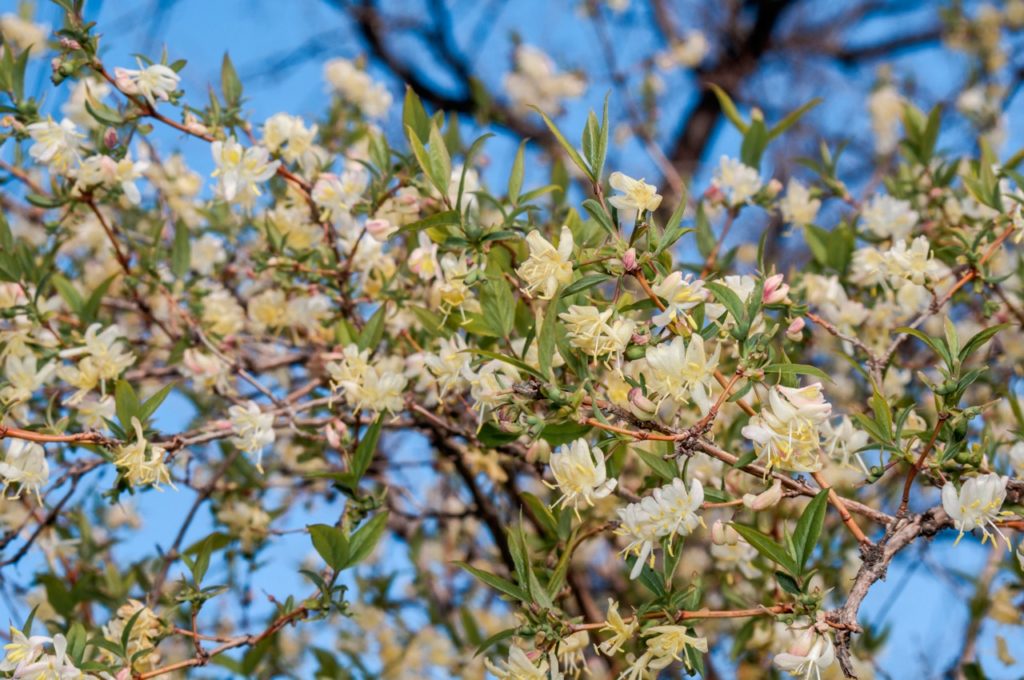
- BOTANICAL NAME: Lonicera fragrantissima
- HARDINESS RATING: H6
- PLANT TYPE: shrub
- FOLIAGE TYPE: deciduous
- FLOWERING SEASON(S): winter / spring
- FRUIT SEASON(S): summer
- SUNLIGHT: full sun / part shade
- EXPOSURE: exposed / sheltered
- SIZE: 1.5-2.5m in height, 1.5-2.5m spread
Another plant that produces cream-coloured flowers, the winter honeysuckle is a deciduous shrub that produces beautiful blooms on its bare branches over the winter season.
Its tiny 2-lipped flowers are often tinged in pink and have a beautifully fragrant aroma that is not too dissimilar to that of freshly-squeezed lemons.
This was one of the plants mentioned by Garden Designer Ian McBain when I spoke to him earlier this year – particularly, he noted its fragrance at a time of year when not much else is offering value:
Growing up to 2.5m tall, this shrub would look great at the back of a border or as part of a more natural wildlife-friendly display.
3) Winterberry
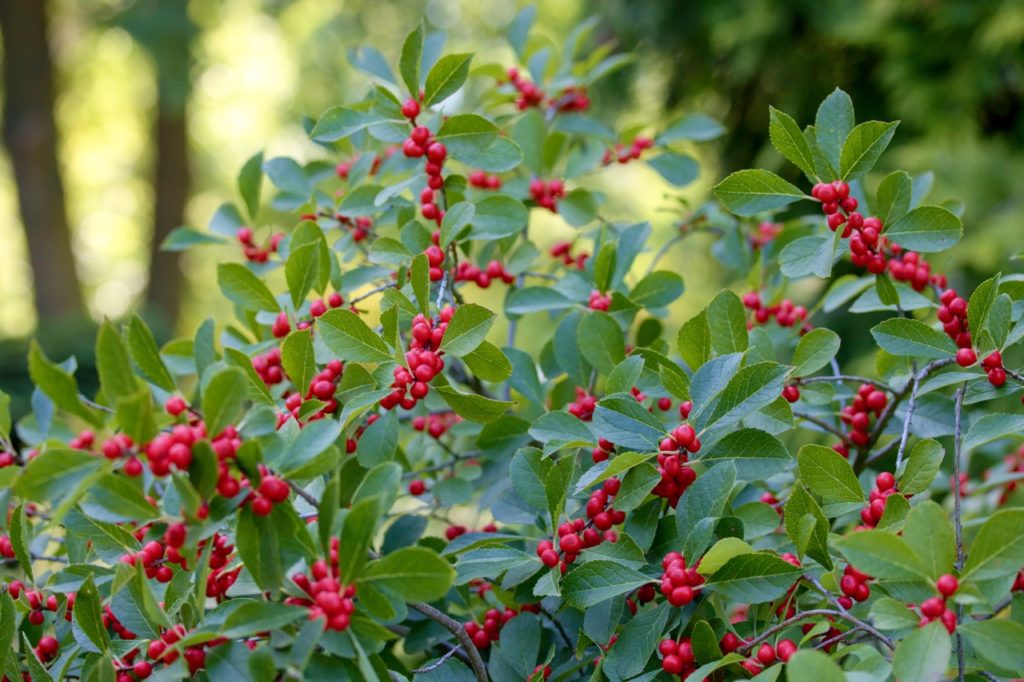
- BOTANICAL NAME: Ilex verticillata
- HARDINESS RATING: H6
- PLANT TYPE: shrub
- FOLIAGE TYPE: deciduous
- FLOWERING SEASON(S): spring
- FRUIT SEASON(S): autumn / winter
- SUNLIGHT: full sun / part shade
- EXPOSURE: exposed / sheltered
- SIZE: 1.5-2.5m in height, 1.5-2.5m spread
Winterberry is a shrub that is prized for its round red berries that are produced in autumn and last long into the winter months.
Its dense dark foliage is great for providing shelter to wildlife during the following nesting season, whilst the berries are often eaten by birds or other small mammals.
Not only is this plant beneficial for the wildlife in your garden, but its striking appearance and big stature, growing up to 2.5m in height, can add a bright burst of colour to your garden during the duller months.
Preferring acidic soil, this plant likes to grow in a damp growing medium, but make sure the soil never becomes waterlogged as this can damage the plant’s health.
4) Common Holly
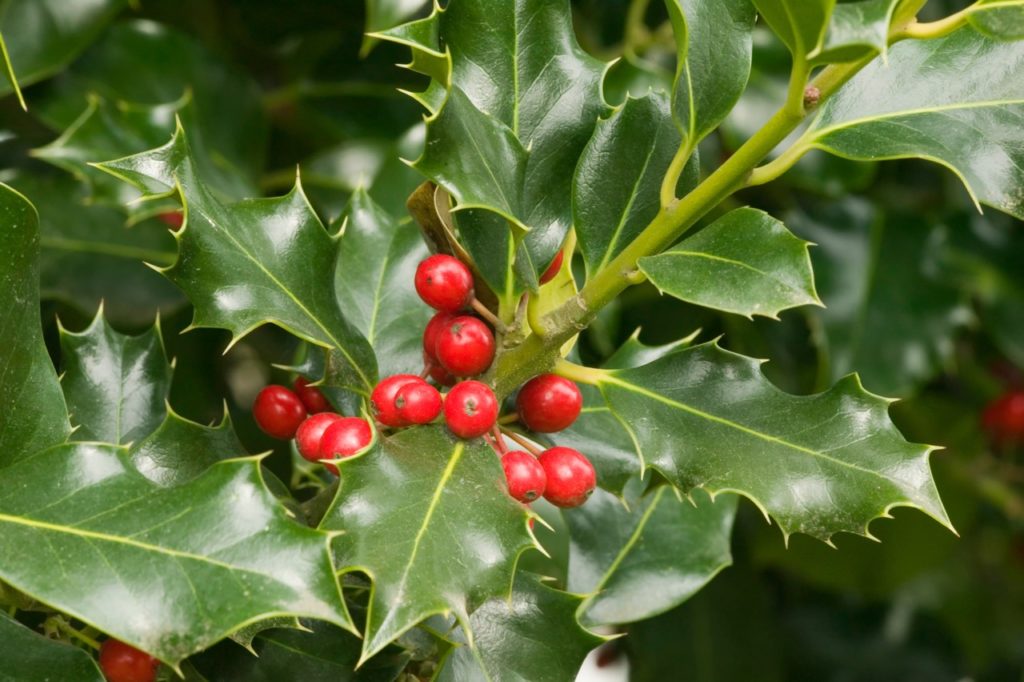
- BOTANICAL NAME: ilex aquifolium
- HARDINESS RATING: H6
- PLANT TYPE: tree
- FOLIAGE TYPE: evergreen
- FLOWERING SEASON(S): spring / summer
- FRUIT SEASON(S): autumn / winter
- SUNLIGHT: full sun / part shade
- EXPOSURE: exposed / sheltered
- SIZE: Up to 15m in height, 4-8m spread
Reaching up to a giant 15m in height, the common holly might just steal the show for the most dramatic plant on this list.
With dark green foliage and bright red berries, this eye-catching evergreen produces distinctive spiky leaves that often have a glossy finish.
Holly is a plant I often think of when considering plants for winter interest, as it is easy to grow, requires little care and can work well as a hedging plant at the back of a garden border.
Some of my favourite varieties include ‘Silver Queen’, prized for its silver variegation on the edge of the green leaves, and ‘Madame Briot’, which produces green and yellow leaves from purple stems.
5) Witch Hazel
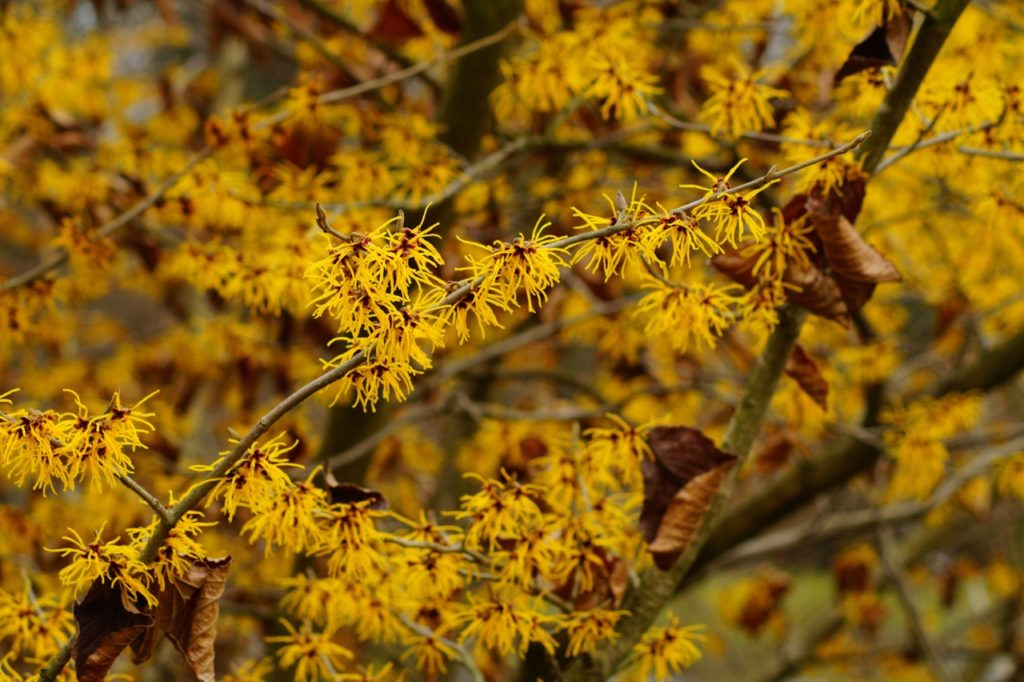
- BOTANICAL NAME: hamamelis
- HARDINESS RATING: H5
- PLANT TYPE: shrub
- FOLIAGE TYPE: deciduous
- FLOWERING SEASON(S): winter
- SUNLIGHT: full sun / part shade
- EXPOSURE: sheltered
- SIZE: 3-6m in height, 3-6m spread
Producing tassel-like blooms that vary in shades from red to yellow, witch hazel is bound to bring some bright interest to your garden over winter.
With stunning scented flowers, witch hazel would work really well planted next to paths or doorways so you can enjoy their aromatic qualities throughout the winter months.
Popular varieties include Chinese witch hazel and Virginian witch hazel, which both produce yellow flowers during the colder months of the year.
“I would also choose these plants for their charming autumn colour on beautifully shaped, lightly twisted leaves too,” adds Peter.
6) Winter Jasmine
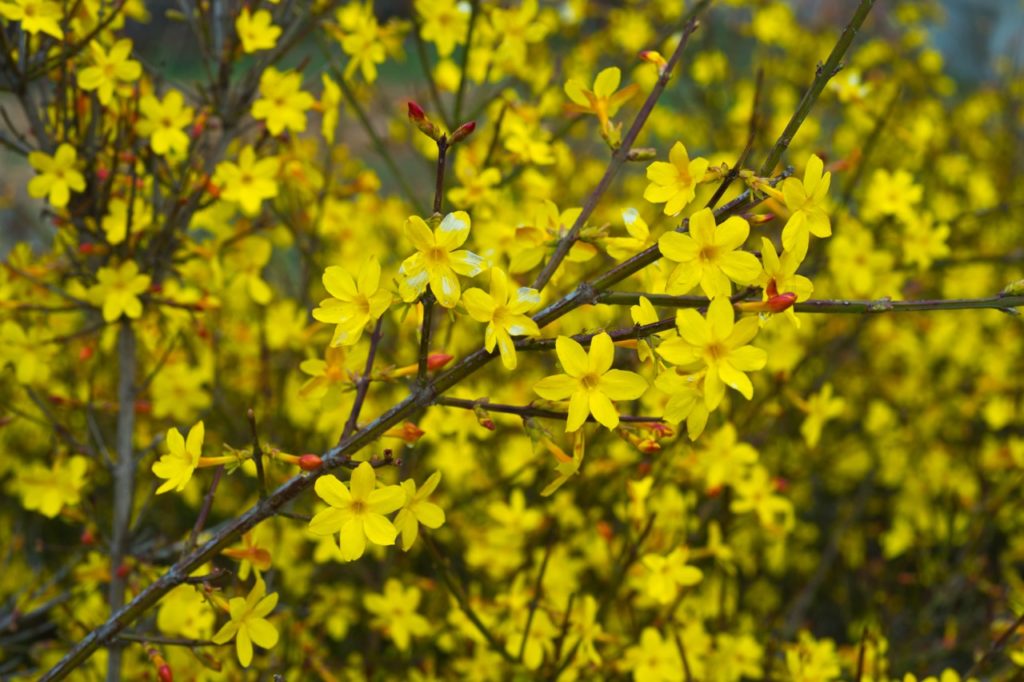
- BOTANICAL NAME: jasminum nudiflorum
- HARDINESS RATING: H5
- PLANT TYPE: shrub
- FOLIAGE TYPE: deciduous
- FLOWERING SEASON(S): winter / spring
- SUNLIGHT: full sun / part shade
- EXPOSURE: sheltered
- SIZE: 1.5-2.5m in height, 1.5-2.5m spread
Winter jasmine is another deciduous shrub that adds colourful floriferous interest during the cold dark months.
In Chinese, this plant’s name, ‘Yingchun’, can be translated as ‘the flower that welcomes spring’, and its star-shaped, yellow petals that bloom right through the winter into the spring demonstrate why.1User-submitted name Yingchun. (n.d.). Behind the Name. Retrieved March 27, 2023, from https://www.behindthename.com/name/yingchun/submitted
This beautiful climber can grow well against a trellis or a wall at the back of a garden border, or be potted and added to container displays or hanging baskets for cascading winter displays.
7) Common Dogwood
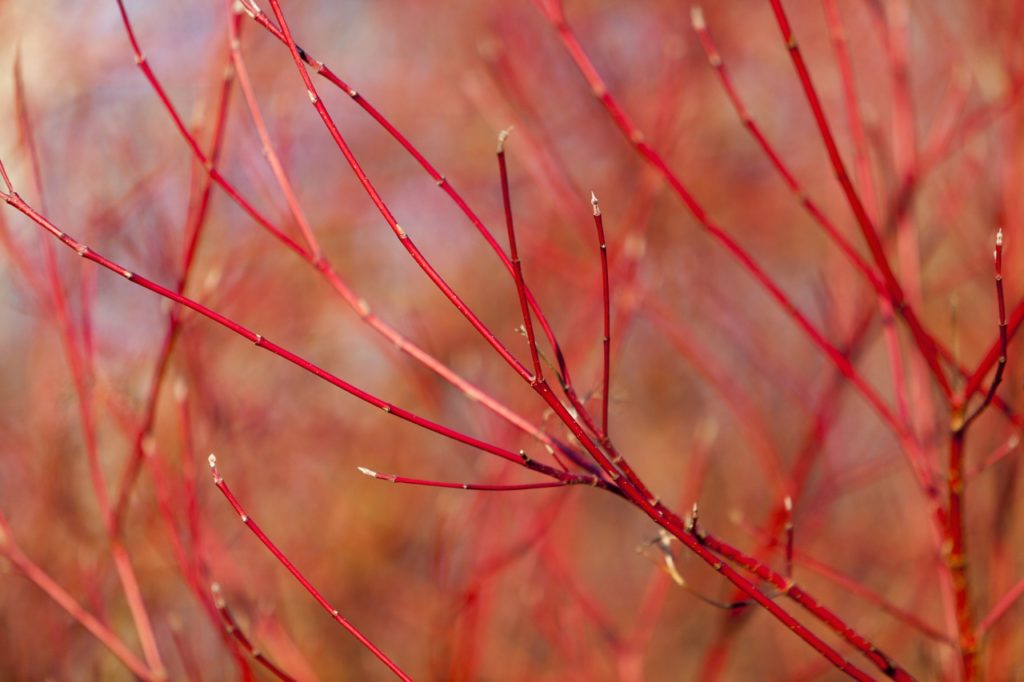
- BOTANICAL NAME: cornus sanguinea
- HARDINESS RATING: H6
- PLANT TYPE: shrub
- FOLIAGE TYPE: deciduous
- FLOWERING SEASON(S): summer
- FRUIT SEASON(S): autumn
- SUNLIGHT: full sun / part shade
- EXPOSURE: exposed / sheltered
- SIZE: 1.5-2.5m in height, 1.5-2.5m spread
If you’re looking for a plant that is great for wildlife but also looks great in the garden over the colder months, then this shrub is the one to beat.
It is the stems of the common dogwood plant that provide interest for your winter garden displays, with the bare bright red branches creating a stunning burst of winter colour.
Dogwood also produces white flowers and black-coloured berries during the year, but they are no contest for the beautiful red stems that look best at the back of a border or as a stand-alone display in its own container or bed.
“If I had to pick one, I would choose Cornus sanguinea ‘Midwinter Fire’ as a cultivar with flaming orange and red tones,” says Peter.
8) Wintersweet
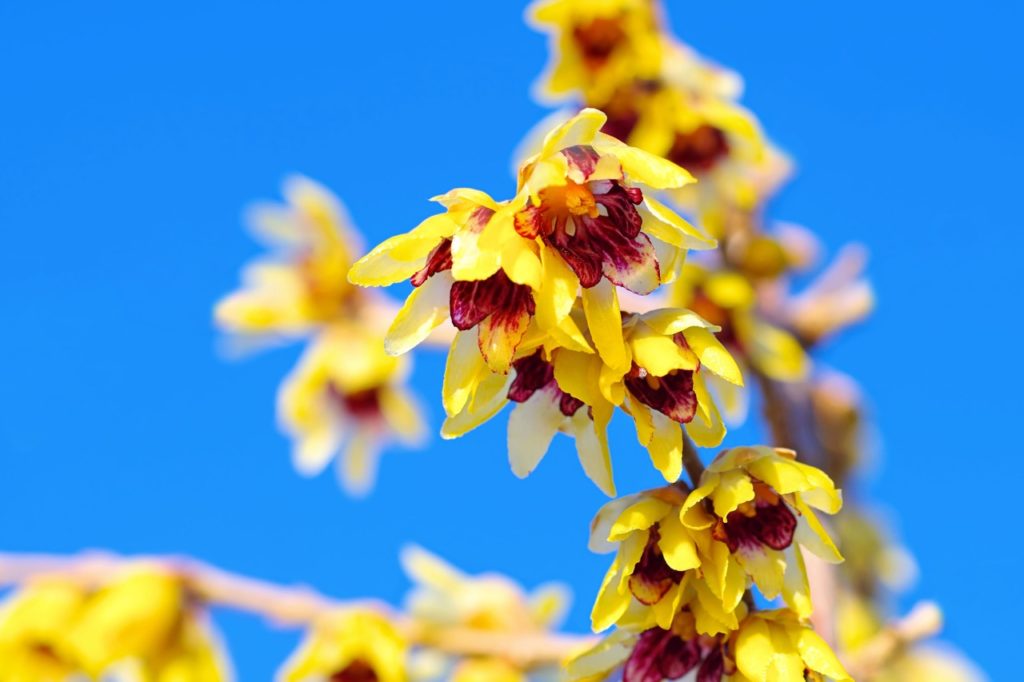
- BOTANICAL NAME: chimonanthus praecox
- HARDINESS RATING: H5
- PLANT TYPE: shrub
- FOLIAGE TYPE: deciduous
- FLOWERING SEASON(S): winter / autumn
- FRUIT SEASON(S): autumn
- SUNLIGHT: full sun
- EXPOSURE: sheltered
- SIZE: 2.5-4m in height, 1.5-2.5m spread
Perhaps my favourite shrub on this list, wintersweet produces small scented flowers with yellow and red layered tepals that grow in clusters from long bare branches over the winter months.
This is another shrub that can be trained against a wall, but it’s important to remember that it needs full sun to thrive, so be mindful if planting in an area of your garden that doesn’t get much light throughout the day.
Due to its discrete but beautiful flowers, I’d recommend planting wintersweet with other more subtle varieties so it does not get lost amongst the crowd, or in its own container.
You should definitely plant these aromatic flowers near a doorway so you can enjoy their scent throughout winter and into spring.
9) Winter Cherry
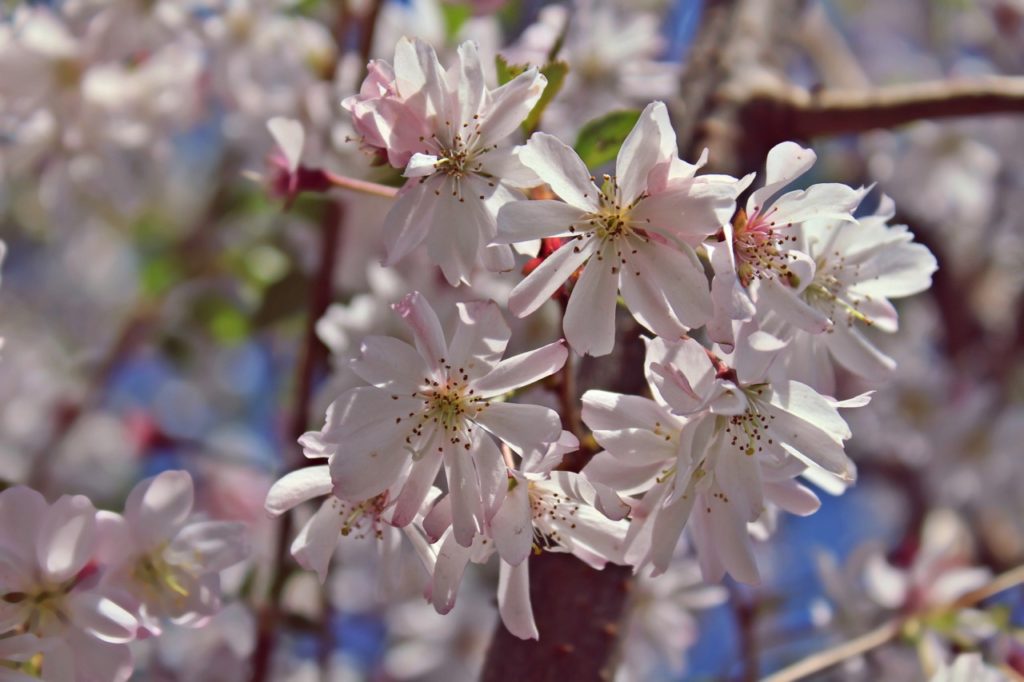
- BOTANICAL NAME: prunus × subhirtella
- HARDINESS RATING: H6
- PLANT TYPE: tree
- FOLIAGE TYPE: deciduous
- FLOWERING SEASON(S): winter / spring
- FRUIT SEASON(S): summer
- SUNLIGHT: full sun
- EXPOSURE: exposed / sheltered
- SIZE: 4-8m in height, 4-8m spread
The winter cherry tree produces small pale-pink flowers towards the end of the winter months and can be used as a centrepiece for your winter garden displays.
Growing up to 8m in height with a similar spread, this floriferous tree can look brilliant in meadow-style gardens thanks to its beautiful blossoms.
If you don’t have the room for a full-sized variety, dwarf cultivars or grafted plants can be grown in pots that are available but are harder to find in the UK.
Perhaps the most popular variety of this cultivar, Prunus x subhirtella ‘Atumnalis’ can be grafted onto dwarfing root stocks to grow to half the height and spread of the common winter cherry tree but still produces those beautiful pale-pink blooms throughout the winter months.
10) Spindle
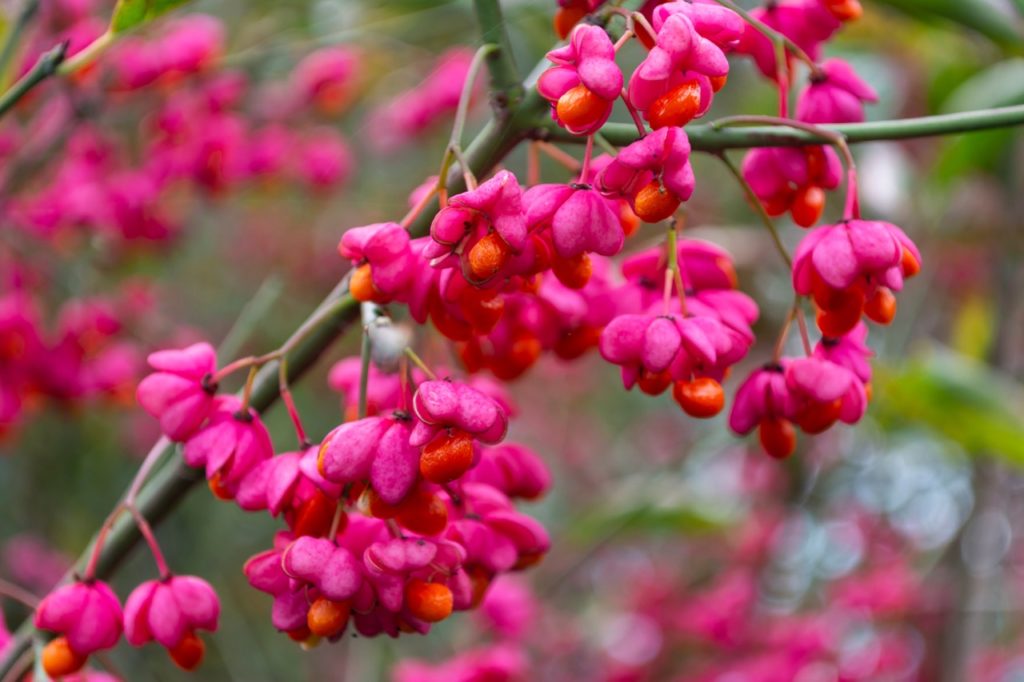
- BOTANICAL NAME: euonymus europaeus
- HARDINESS RATING: H6
- PLANT TYPE: shrub
- FOLIAGE TYPE: deciduous
- FLOWERING SEASON(S): summer
- FRUIT SEASON(S): autumn /winter
- SUNLIGHT: full sun / part shade
- EXPOSURE: exposure / sheltered
- SIZE: 2.5-4m in height, 2.5-4m spread
Last but certainly not least, spindle is a great addition to any winter display that needs a burst of colour.
What makes this deciduous shrub stand out from the rest is the orange berries that are produced from the small pink flowers that grow from the bare branches in the colder months of the year.
Not only do they bring a unique colour to your winter garden, but they are extremely versatile and can be grown as hedges, at the back of garden beds, or trained along a trellis or wall.
“I would select a sheltered position for these spindles to prevent berries dropping too quickly in the autumn,” shares Peter.
My favourite variety, ‘Red Cascade’, produces bright scarlet leaves over the winter months alongside their orange berries.
References
- 1User-submitted name Yingchun. (n.d.). Behind the Name. Retrieved March 27, 2023, from https://www.behindthename.com/name/yingchun/submitted

